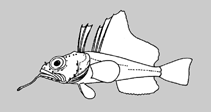Pogonophryne pavlovi Balushkin, 2013
را بارگذاری کني تصاوير و فيلم ها
Pictures | تصوير گوگلNo image available for this species;
drawing shows typical species in Artedidraconidae.
Pictures | تصوير گوگلNo image available for this species;
drawing shows typical species in Artedidraconidae.
Common names from other countries
رده بندی / Names اسامي عام | مترادف | Catalog of Fishes(جنس, گونه ها) | ITIS | CoL | WoRMS | Cloffa
> Perciformes/Notothenioidei (Icefishes) > Artedidraconidae (Barbled plunderfishes)
Etymology: Pogonophryne: Greek, pogon = beard + Greek, phrynos = toad (Ref. 45335); pavlovi: Named for Dmitry Sergeevich Pavlov, Russian ichthyologist, for his 75th birth anniversary.
Etymology: Pogonophryne: Greek, pogon = beard + Greek, phrynos = toad (Ref. 45335); pavlovi: Named for Dmitry Sergeevich Pavlov, Russian ichthyologist, for his 75th birth anniversary.
Environment: milieu / climate zone / depth range / distribution range بوم شناسي
دريايي موجوداتی که در اعماق زیر 200 متر زندگی و تغذیه می کنند; تغييرات عمق 1422 - 1623 m (Ref. 94147). Polar
پراكنش كشورها | مناطق سازمان خوار و بار جهاني (FAO) | Ecosystems | ظهور | Point map | معرفي | Faunafri
Antarctic Pacific: Antarctica, Ross Sea.
Size / Weight / سن
توصيف مختصر كليدهاي شناسايي | ريخت شناسي | ريخت ستجي بوسيله انداره گيري
خارهاي باله پشتي (کل) : 2; شعاع نرم باله پشتي (کل) : 27 - 28; شعاع نرم باله مخرجي: 18. This species is distinguished from its congeners belonging in the albipinna group by the following set of characters: mental barbel with a long (61.2-65.2% of barbel length) terminal expansion composed of densely packed, brain-like convolutions; fins dark basally, light distally; dorsal lateral pores (tubular scales) 26-28; gill rakers on first gill arch 19 (Ref. .94147).
Life cycle and mating behavior بلوغ | تولید مثل | تخم ریزی | تخم ها | Fecundity | توزاد ( لارو)
مآخذ اصلی
Upload your references | مراجع | هماهنگ كننده | همكاران
Balushkin, A.V., 2013. A new species of Pogonophryne (Perciformes: Notothenioidei: Artedidraconidae) from the deep Ross Sea, Antarctica. Proc. Zool. Inst. Rus. Acad. Sci. 317(2):119-124. (Ref. 94147)
خطر برای انسان ها
Harmless
استفاده انسانی
ماهي گيري – شيلات: از بی علاقه گی
FAO(Publication : search) | FishSource |
اطلاعات بيشتر
Trophic ecology
اقلام غذايي
تركيب غذايي
مصرف غذايي
Food rations
شکارچیان
اقلام غذايي
تركيب غذايي
مصرف غذايي
Food rations
شکارچیان
Ecology
بوم شناسي
Home ranges
بوم شناسي
Home ranges
Population dynamics
Growth parameters
Max. ages / sizes
Length-weight rel.
Length-length rel.
نوسانات طولی
Mass conversion
بازسازی
فراواني
Growth parameters
Max. ages / sizes
Length-weight rel.
Length-length rel.
نوسانات طولی
Mass conversion
بازسازی
فراواني
Life cycle
تولید مثل
بلوغ
Fecundity
تخم ریزی
Spawning aggregations
تخم ها
نمو تخم
توزاد ( لارو)
پويايي لاروي
تولید مثل
بلوغ
Fecundity
تخم ریزی
Spawning aggregations
تخم ها
نمو تخم
توزاد ( لارو)
پويايي لاروي
Anatomy
منطقه آبششي
Brain
Otolith
منطقه آبششي
Brain
Otolith
Physiology
Body composition
Nutrients
Oxygen consumption
Swimming type
Swimming speed
Visual pigments
Fish sound
Diseases & Parasites
Toxicity (LC50s)
Body composition
Nutrients
Oxygen consumption
Swimming type
Swimming speed
Visual pigments
Fish sound
Diseases & Parasites
Toxicity (LC50s)
Genetics
ژنتيك
Heterozygosity
وارث
ژنتيك
Heterozygosity
وارث
Human related
Aquaculture systems
نمايه هاي آبزي پروري
نژادها
Ciguatera cases
Stamps, coins, misc.
Aquaculture systems
نمايه هاي آبزي پروري
نژادها
Ciguatera cases
Stamps, coins, misc.
ابزارها
E-book | راهنماي صحرايي | امكان نرم افزاري بسامد طولي | ابزار تاريخ زيستي | نقشه نقطه ای | Classification Tree
| Catch-MSY |
گزارش های ويژه
راجع به نگهداری آکواريم ملاحظه کنيد | برگه اطلاعات و مشخصات گونه ها را ملاحظه کنيد | برگه اطلاعات و مشخصات آبزی پروری را ببينيد
بارگيری XML
صفحه خلاصه | Point data | اسامي عام | تصاوير
منابع اينترنتي
Aquatic Commons | BHL | Cloffa | Websites from users | فيش واچر را ببينيد | CISTI | Catalog of Fishes(جنس, گونه ها) | DiscoverLife | ECOTOX | Faunafri | Fishtrace | GenBank(ژنوم, نوکلئوتيد) | GloBI | GOBASE | | Google Books | Google Scholar | Google | IGFA World Record | MitoFish | Otolith Atlas of Taiwan Fishes | PubMed | Reef Life Survey | Scirus | SeaLifeBase | Tree of Life | Wikipedia(برو, جستجو) | World Records Freshwater Fishing | Zoobank | Zoological Record
Estimates based on models
Phylogenetic diversity index (Ref. 82804): PD50 = No PD50 data [Uniqueness, from 0.5 = low to 2.0 = high].
Bayesian length-weight: a=0.00501 (0.00240 - 0.01046), b=3.13 (2.94 - 3.32), in cm Total Length, based on LWR estimates for this (Sub)family-body shape (Ref. 93245).
Trophic level (Ref. 69278): 3.3 ±0.5 se; based on size and trophs of closest relatives
Fishing Vulnerability (Ref. 59153): Low vulnerability (15 of 100).




